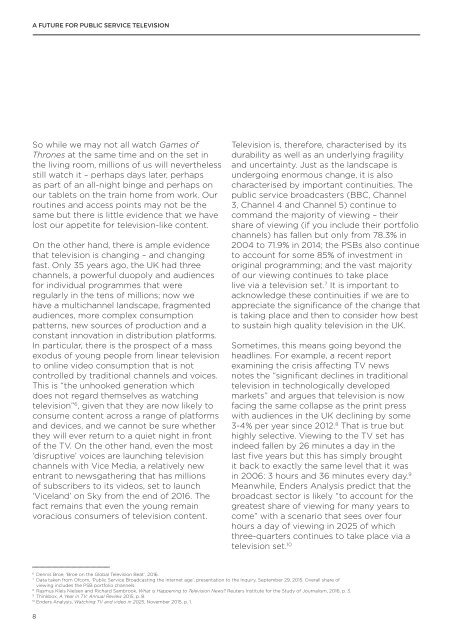A FUTURE FOR PUBLIC SERVICE TELEVISION CONTENT AND PLATFORMS IN A DIGITAL WORLD
FOTV-Report-Online-SP
FOTV-Report-Online-SP
You also want an ePaper? Increase the reach of your titles
YUMPU automatically turns print PDFs into web optimized ePapers that Google loves.
A <strong>FUTURE</strong> <strong>FOR</strong> <strong>PUBLIC</strong> <strong>SERVICE</strong> <strong>TELEVISION</strong><br />
So while we may not all watch Games of<br />
Thrones at the same time and on the set in<br />
the living room, millions of us will nevertheless<br />
still watch it – perhaps days later, perhaps<br />
as part of an all-night binge and perhaps on<br />
our tablets on the train home from work. Our<br />
routines and access points may not be the<br />
same but there is little evidence that we have<br />
lost our appetite for television-like content.<br />
On the other hand, there is ample evidence<br />
that television is changing – and changing<br />
fast. Only 35 years ago, the UK had three<br />
channels, a powerful duopoly and audiences<br />
for individual programmes that were<br />
regularly in the tens of millions; now we<br />
have a multichannel landscape, fragmented<br />
audiences, more complex consumption<br />
patterns, new sources of production and a<br />
constant innovation in distribution platforms.<br />
In particular, there is the prospect of a mass<br />
exodus of young people from linear television<br />
to online video consumption that is not<br />
controlled by traditional channels and voices.<br />
This is “the unhooked generation which<br />
does not regard themselves as watching<br />
television” 6 , given that they are now likely to<br />
consume content across a range of platforms<br />
and devices, and we cannot be sure whether<br />
they will ever return to a quiet night in front<br />
of the TV. On the other hand, even the most<br />
‘disruptive’ voices are launching television<br />
channels with Vice Media, a relatively new<br />
entrant to newsgathering that has millions<br />
of subscribers to its videos, set to launch<br />
‘Viceland’ on Sky from the end of 2016. The<br />
fact remains that even the young remain<br />
voracious consumers of television content.<br />
Television is, therefore, characterised by its<br />
durability as well as an underlying fragility<br />
and uncertainty. Just as the landscape is<br />
undergoing enormous change, it is also<br />
characterised by important continuities. The<br />
public service broadcasters (BBC, Channel<br />
3, Channel 4 and Channel 5) continue to<br />
command the majority of viewing – their<br />
share of viewing (if you include their portfolio<br />
channels) has fallen but only from 78.3% in<br />
2004 to 71.9% in 2014; the PSBs also continue<br />
to account for some 85% of investment in<br />
original programming; and the vast majority<br />
of our viewing continues to take place<br />
live via a television set. 7 It is important to<br />
acknowledge these continuities if we are to<br />
appreciate the significance of the change that<br />
is taking place and then to consider how best<br />
to sustain high quality television in the UK.<br />
Sometimes, this means going beyond the<br />
headlines. For example, a recent report<br />
examining the crisis affecting TV news<br />
notes the “significant declines in traditional<br />
television in technologically developed<br />
markets” and argues that television is now<br />
facing the same collapse as the print press<br />
with audiences in the UK declining by some<br />
3-4% per year since 2012. 8 That is true but<br />
highly selective. Viewing to the TV set has<br />
indeed fallen by 26 minutes a day in the<br />
last five years but this has simply brought<br />
it back to exactly the same level that it was<br />
in 2006: 3 hours and 36 minutes every day. 9<br />
Meanwhile, Enders Analysis predict that the<br />
broadcast sector is likely “to account for the<br />
greatest share of viewing for many years to<br />
come” with a scenario that sees over four<br />
hours a day of viewing in 2025 of which<br />
three-quarters continues to take place via a<br />
television set. 10<br />
6<br />
Dennis Broe, ‘Broe on the Global Television Beat’, 2016.<br />
7<br />
Data taken from Ofcom, ‘Public Service Broadcasting the internet age’, presentation to the Inquiry, September 29, 2015. Overall share of<br />
viewing includes the PSB portfolio channels.<br />
8<br />
Rasmus Kleis Nielsen and Richard Sambrook, What is Happening to Television News? Reuters Institute for the Study of Journalism, 2016, p. 3.<br />
9<br />
Thinkbox, A Year in TV: Annual Review 2015, p. 8.<br />
10<br />
Enders Analysis, Watching TV and video in 2025, November 2015, p. 1.<br />
8


